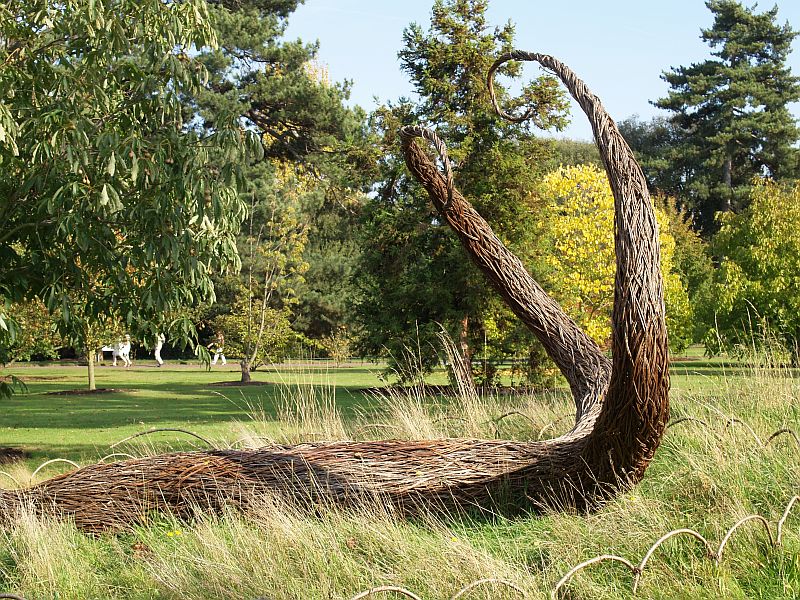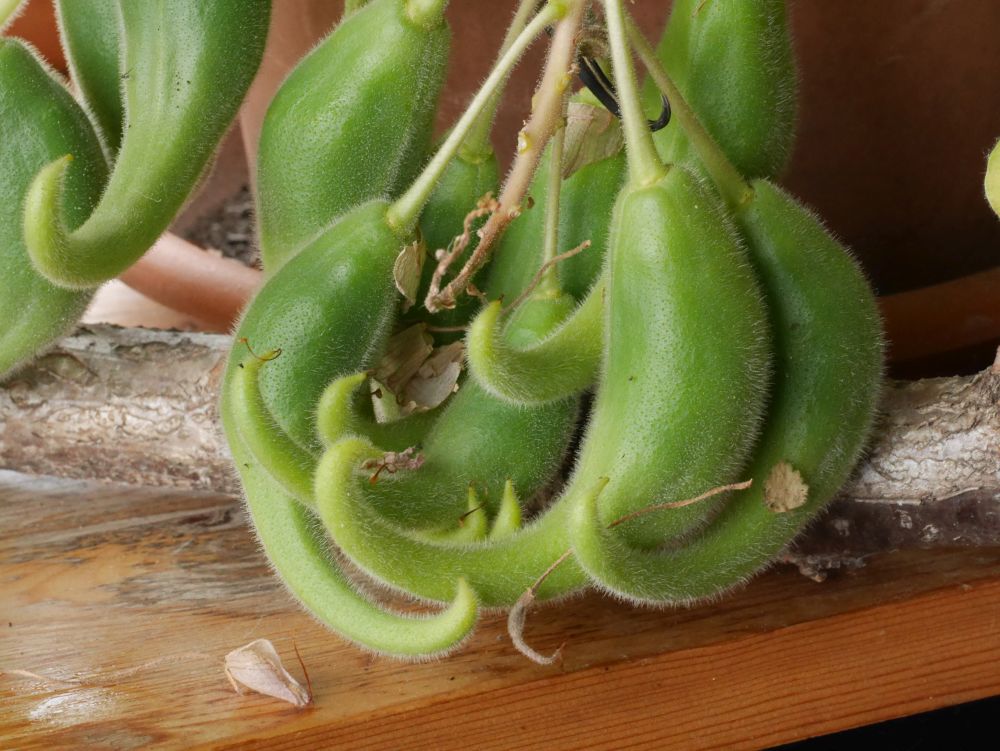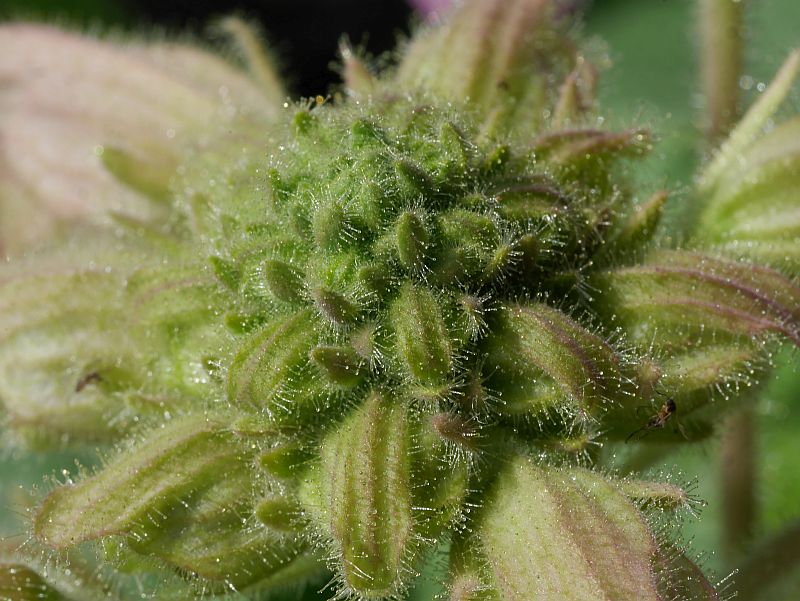It’s always nice to spot a bee beetle / humlebille (Trichius fasciatus) in the garden. I discovered this one on the first Sanguisorba flower of the year!
Monthly Archives: June 2020
Nice hairdo!
Somebody commented that this Jack-go-to-bed-by-noon (Tragopogon pratensis) has a hairdo like mine ;) I think it’s rather smart!
Mother and daughter habby
The daughter Hablitzia tamnoides (Caucasian spinach / stjernemelde) was self-sown in the middle of what was where we parked the car and now where I store plants until they’re ready to plant out. It is now almost as big as its mother which is at the back, now about 18 years old!
Devil’s claw as an edible house plant
Update 160121: The single plant produced many (over 20) fruits and masses of seed. I’ve added a few pictures at the bottom. I’ll be offering seed to members of KVANN / Norwegian Seed Savers (kvann.no).
Proboscidea louisianica subsp. fragrans (in the Martyniaceae) is currently flowering in the window sill and as its name suggest it has a beautiful fragrance! I’ve tried unsuccessfully growing it outside in the past, so this time I was given seed I’m trying it as an edible house plant. Its English names are variously devil’s claw, unicorn-plant, ram’s horn, aphid trap, goat’s head and elephant tusks. Sadly only one seed germinated and it only rarely self-pollinates (bees do the work, so I’ve been playing the bee using a paint brush…on the off-chance I might get a fruit). The fruits are sometimes compared with okra (Abelmoschus esculentus) or even the climbing cucurbit, achocha (Cyclanthera spp.) from South America. Years ago in 2007, I did get one fruit when I grew it in my old unheated greenhouse:
The unripe seed pods were traditionally cooked as a vegetable and added to soups or pickled and the leaves were also used as a potherb with beans. The immature oil rich seeds were also eaten raw or were roasted or dried and eaten like pine nuts.


Apart from being an important food plant for First Peoples, the dried seed pods were also incorporated into basketry to make patterns, plants were even selected for longer claws and used for sewing and a black dye was also obtained.
However, I’ll probably just enjoy it as a fragrant unusual house plant with a potential for food and hope it will live up to its alternative name, aphid trap!
And finally, one of Tom Hare’s wonderful art installations, Devil’s Claw, in Kew Gardens in 2011:

Pictures added January 2021:




Udo record
My 18 year old udo (Aralia cordata) is probably the tallest ever this year (I’m 6 ft or 1.8m). After the coldest May for many years with plenty of rain, June is likely to be the warmest ever in this area with several days over 30C and a probable (to be confirmed) highest temperature for this area at 34.3C at the airport on Saturday. Cold damp spring temperatures are perfect for udo! I’m dreaming of fields of udo replacing the barley and oats!
More perennial kales
The perennial kales overwintered well the last two winters and are looking good. I showed a video of one I got from Walsall Allotments in Birmingham, UK a few years ago here last week: https://www.edimentals.com/blog/?p=25787
The first below is one of Chris Homanics’ perennial crosses (I lost track of which cross this is). It has large dark glossy leaves (a bit reminiscent of Glazed collards) and hasn’t flowered, concentrating instead its energy into producing leaves! This is a keeper.
This is followed by non-flowering offspring of my Daubenton cross with Purple Sprouting Broccoli in 2012 and still alive https://www.edimentals.com/blog/?page_id=1632. These have inherited the daubenton genes but one is taller and has bigger leaves. I’m still playing with the offspring on the broccoli side, but they are less perennial but some have survived for 5 years but the broccolis are smaller than the father, but still useful.
Finally is a current picture of Daubenton variegated.
AND Diamond back moth (kålmøll) is now here in large numbers (over 100) and will have almost no impact on these kales, nor will other pests!
1. Homanics Norway perennial kale
2. Daubenton like (from Daubenton x Late Purple Broccoli cross)
3. Daubenton variegated 
Sun pillar
Sun pillar just before sunrise at 3 am chez moi!

Mallows in season #2
…and my second best mallow is the hollyhock mallow or greater musk mallow / rosekattost (Malva alcea), hardy and reliably perennial, here with perennial kale “Daubenton”, flower buds and stems of Scorzonera hispanica, Johannes’ shallot (Allium x cornutum; see https://www.edimentals.com/blog/?p=22601) and annual chopsuey greens or shungiku (Glebionis coronaria, formerly Chrysanthemum coronarium).

Mallows in season
Mallows (Malva spp.) are now in season for harvesting and will from now until autumn be an important source of greens and edible flowers. The best part are the flower buds with surrounding leaves. We started earlier in the week with musk mallow / moskuskattost (Malva moschata), a reliable perennial here that also self-sows in just about the right quantity. Traditionally, Malvas were often used in soups, so it was a good addition to pea soup along with
Hybrid onions (Allium senescens x)
Rumex acetosa (mixed Russian cultivars); sorrel / engsyre
Campanula trachelium tops (nettle leaved bellflower / nesleklokke)
Myrrhis odorata unripe seed pods (sweet cicely / spansk kjørvel)
Origanum vulgare (oregano / bergmynte)

The Allium garden at Ringve
19th June 2020: Video update from the Allium (Chicago) garden at the NTNU Ringve Botanical Gardens in Trondheim. The heat wave has brought many species into flower and the garden’s looking great!
The official opening of the garden, planned for August, has been postponed to 2021. We are working on plant signs which will hopefully be added later in the summer.
The garden currently contains some 300 accessions including around 100 Allium species and many old Norwegian onions collected over several years from all over the country and funded by Norsk Genressurssenteret and Landbruksdirektoratet.
The signs for the garden are in part funded through a gift from Skjærgaarden (https://www.skjaergaarden.no) to KVANN (Norwegian Seed Savers) who have decided to use the gift at Ringve (see https://www.facebook.com/skjaergaarden.no/videos/2972781459487864)




